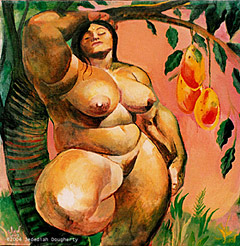 |
 |
 |
 News Around the Republic of Mexico | June 2005 News Around the Republic of Mexico | June 2005  
Mango Name Incites Spat
 Wire services Wire services


| | The way Mexico sees it, the Manila mango long ago became a product unique to this country. |
Since the thriving galleon trade between New Spain and the Philippines first brought the seedlings of the Manila mango to Acapulco more than 200 years ago, Mexico has gradually made the fruit its own.

It now wants to officially adopt the name, but the Philippine government is fighting custody.

In the globalized 21st century, as both countries seek to expand exports of mangoes and other fresh produce to nations worldwide, Mexican growers have launched an effort to obtain a socalled geographical indication or domain of origin for the Manila mango, a type of patent that would restrict the use of the name Manila to mangoes grown in Mexico.

A domain of origin certifies a product's excellence, increasing its exports. It also protects its name from infringement by others in this case, growers in the Philippines, where mangoes are now produced under the name Manila Super Mango, or Carabao.

The Manila mango does not pose much of a threat to the Philippines currently; it represents less than 1 percent of Mexico's mango exports due to the variety's fragility and a fruit-fly problem, the latter of which is also an obstacle to obtaining the domain of origin.

"We are still a long way from obtaining the denomination," said Jorge Mendoza, a member of the state committee for mango production in the Gulf coast state of Veracruz, where most Manila mangoes are cultivated.

But Mexican mango growers do hope one day to achieve it. They would like to convert the small, pale-yellow Manila whose delicate skin and intensely juicy flesh makes it one of the nation's favorite domestically consumed mangoes into an export success, including in markets targeted by the Philippines.

In the meantime, Mexico already is gaining some mileage from the Manila name through other mangoes. In the United States, the name "Honey Manila" is often applied to the widely exported Ataulfo variety from southern Chiapas state, "because the Americans can't pronounce 'Ataulfo,' " said Blanca Nelly Partida, a representative of Mexico's national mango export association, EMEX.

The Filipinos don't want to lose the right to use a name that originated in their country or to see Mexico profiting unfairly from it. They also have hinted that they might try to obtain the domain of origin for themselves.

"Mexico acknowledges that their Manila mango variety came from the Philippines," said Adrián S. Cristóbal, director-general of the Philippine Intellectual Property Office, or IPO. "By using the name Manila mango, the public can be misled as to the true origin of the fruit. ... This is essentially unfair competition."

Cristóbal said government officials may resort to the international Agreement on Trade-Related Aspects of Intellectual Property Rights, or TRIPS, which allows nations belonging to the World Trade Organization to stop other members from obtaining a domain of origin if it misleads consumers as to a product's true origin.

The way Mexico sees it, the Manila mango long ago became a product unique to this country.

Although Manila seedlings arrived in Mexico from the Philippines in 1779 during the galleon trade, the variety was crossed with other mangoes over the years, so today's Manila mangoes possess a genetic mix found only in Mexico, said Héctor Cabrera, an expert with the National Institute of Forest, Agricultural and Livestock research.

"It shouldn't be confused with the original Carabao," he said.

Mexico, the world's largest mango exporter, shipped more than US130 million in mangoes in 2004, the majority to the United States, with smaller markets in Canada, Japan and European countries, respectively, the Economy Department reported.

The Philippines shipped US31 million to its four top markets in 2004: Japan, Hong Kong, South Korea, and China, according to the country's trade department. Both countries are looking to expand their mango export markets, raising the level of competition between them.

Seeking domains of origin is an extremely strong trend in today's cutthroat global economy, where companies are fighting to keep a competitive edge and not leave themselves unprotected, said Mexico agricultural economist Yolanda Trapaga.

But the Manila mango case is uncommon and could have an impact on other products in the future because it redefines the label's traditional concept of origin, Trapaga said.

While the designation usually is based on a product and where its from such as the town of Tequila, Mexico, or the province of Champagne, France the Manila mango's domain would refer not so much to the fruit itself as to the hybridization and cultivation practices in Mexico that supposedly make the variety unique.

All countries seeking the domain of origin must comply with WTO rules. But because the WTO does not currently recognize, or regulate, the domain of origin, most countries seeking the designation work out mutually acceptable agreements with their trading partners, Trapaga said. Mexico's next step, therefore is "to start hashing this out with the Philippines," she said. "There has to be a bilateral negotiation, to see where it goes." | 
 | |
 |



